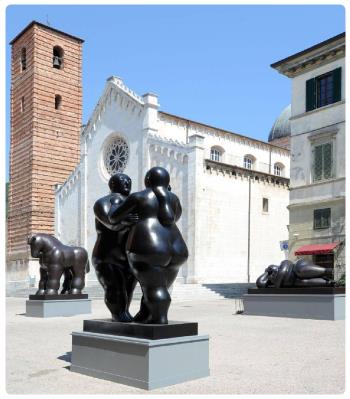|
What
to see in Pietrasanta - The 20 places not to be missed
|
Pietrasanta
is an ancient, elegant and quiet town in the province of
Lucca,
famous for the beauty of its architecture and for the artistic
processing of marble. It has an old town centre rich in
monuments and a fabulous Piazza del Duomo, on which the most
important city buildings overlook. It has been a refuge for
sculptors for six centuries and continues to be chosen by famous
artists and young talents. It was here, that Michelangelo,
Henry Moore, and more recently, Fernando Botero
chose to reside in part, given the proximity of the city to the
marble quarries of Carrara. |
|
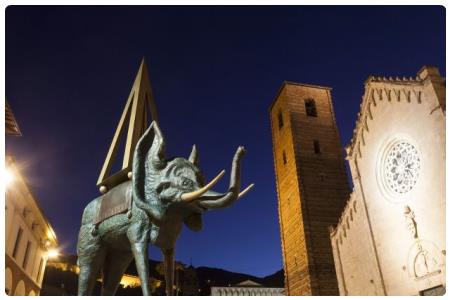 Pietrasanta,
whose narrow streets follow the Roman grid track (insolite for a Tuscan
village), has maintained its status of epicenter and creative home to
more than 15 contemporary art galleries. The high season for art
galleries runs from June to September and it is during this period that
Piazza del Duomo comes alive with events. As we have already seen in the
guide of Pietrasanta,
the city is more than a colony of international artists, it has a very
rich historical centre full of interesting architecture, starting from
the already mentioned and beautiful Piazza del Duomo. Here you can
admire the Cathedral of San Martino, built between the 13th and 14th
centuries in Romanesque-Gothic style, the Church of Sant'Agostino
in Romanesque style with its beautiful Baroque bell tower, the
Tower of the Hours, the Column of Marzocco and the
Monument of Leopold II. The nearby parish church of Valdicastello
and the Church of San Francesco are worth a visit. There are also
interesting museums, including the Archaeological Museum Bruno
Antonucci, the
Bozzetti Museum,
which preserves works by local artists, the Barsanti Museum
(dedicated to the internal combustion engine, invention of
Eugenio
Barsanti), the museum-home of the poet
and Nobel Prize winner Giosuè Carducci in Valdicastello.
Among the civil buildings, you can see Palazzo Pretorio,
Palazzo dei Capitani di Giustizia, Palazzo Panichi, today
seat of the post offices. Pietrasanta,
whose narrow streets follow the Roman grid track (insolite for a Tuscan
village), has maintained its status of epicenter and creative home to
more than 15 contemporary art galleries. The high season for art
galleries runs from June to September and it is during this period that
Piazza del Duomo comes alive with events. As we have already seen in the
guide of Pietrasanta,
the city is more than a colony of international artists, it has a very
rich historical centre full of interesting architecture, starting from
the already mentioned and beautiful Piazza del Duomo. Here you can
admire the Cathedral of San Martino, built between the 13th and 14th
centuries in Romanesque-Gothic style, the Church of Sant'Agostino
in Romanesque style with its beautiful Baroque bell tower, the
Tower of the Hours, the Column of Marzocco and the
Monument of Leopold II. The nearby parish church of Valdicastello
and the Church of San Francesco are worth a visit. There are also
interesting museums, including the Archaeological Museum Bruno
Antonucci, the
Bozzetti Museum,
which preserves works by local artists, the Barsanti Museum
(dedicated to the internal combustion engine, invention of
Eugenio
Barsanti), the museum-home of the poet
and Nobel Prize winner Giosuè Carducci in Valdicastello.
Among the civil buildings, you can see Palazzo Pretorio,
Palazzo dei Capitani di Giustizia, Palazzo Panichi, today
seat of the post offices.
Here is a list of things to see (after having seen them, take a
tour of
Marina di Pietrasanta, its beaches, a few kilometers from
Pietrasanta), among those of Forte dei Marmi, Viareggio
and Lido di Camaiore, attract crowds of holidaymakers every year
and you will find a large number of elegant restaurants, shops and
hotels.
Piazza del Duomo (Dome
Square)
 Piazza
del Duomo cuts the city in two, and presents itself in all its
beauty, with the presence of modern sculptures on temporary exhibition,
well harmonized in the historical context. The Cathedral of San
Martino, the Praetorian Palace, the Civic Theatre, the
Church of Sant'Agostino and other noble palaces overlook it. The
square is large and in addition to the historic buildings, it houses
some cafes. Surely the view of this beautiful square remains impressed
in the mind, for its majesty but also for the fact that here are set up
rotating exhibitions with works by great artists (from
Dalì
to Gustavo Aceves, Moore to
Mirò).
Every first Sunday of the month there is a beautiful market,
during which are housed about 70 antique exhibitors who sell furniture,
wooden sculptures and marble, modern objects, etc.. Piazza
del Duomo cuts the city in two, and presents itself in all its
beauty, with the presence of modern sculptures on temporary exhibition,
well harmonized in the historical context. The Cathedral of San
Martino, the Praetorian Palace, the Civic Theatre, the
Church of Sant'Agostino and other noble palaces overlook it. The
square is large and in addition to the historic buildings, it houses
some cafes. Surely the view of this beautiful square remains impressed
in the mind, for its majesty but also for the fact that here are set up
rotating exhibitions with works by great artists (from
Dalì
to Gustavo Aceves, Moore to
Mirò).
Every first Sunday of the month there is a beautiful market,
during which are housed about 70 antique exhibitors who sell furniture,
wooden sculptures and marble, modern objects, etc..
Up
Cattedrale di Pietrasanta
(Cathedral of Pietrasanta)
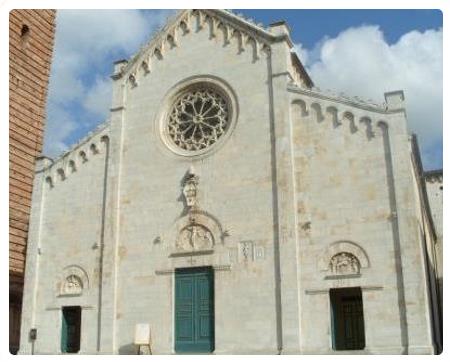 The
mother church of Pietrasanta, its Cathedral, also known as the "Collegiata
di San Martino di Pietrasanta", impresses with its white façade,
divine in the purity of that material of which the city is rich: marble.
The church was founded in the 13th century, well before 1223, when the
first news of its existence dates back to 1223. The external
structure has three naves, two side aisles and a central one above
the height of the former, with the classic sloping profile and a central
marble rose window. The style is Romanesque-Renaissance... deepen by
reading our article on the
Cathedral of Pietrasanta. The
mother church of Pietrasanta, its Cathedral, also known as the "Collegiata
di San Martino di Pietrasanta", impresses with its white façade,
divine in the purity of that material of which the city is rich: marble.
The church was founded in the 13th century, well before 1223, when the
first news of its existence dates back to 1223. The external
structure has three naves, two side aisles and a central one above
the height of the former, with the classic sloping profile and a central
marble rose window. The style is Romanesque-Renaissance... deepen by
reading our article on the
Cathedral of Pietrasanta.
Up
Campanile del Duomo di Pietrasanta
(Bell Tower of the Cathedral of Pietrasanta)
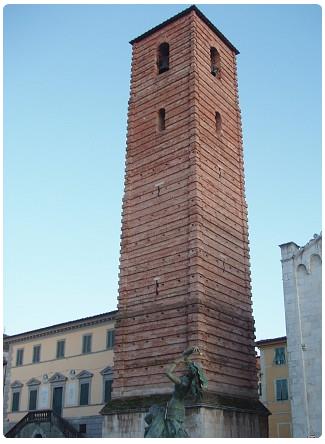 Certainly
of historical interest is the adjacent bell tower of St. Martin's
Cathedral, 36 meters high made of red brick on view. Its
construction was completed in 1520, according to an original plan of
1518, which provided for the marble cladding, like the mother church,
but which was never completed. The project is attributed to the
architect Donato Benti, even if, according to some academic
research, his architectural origin could not be less than Michelangelo's
work, who lived in Pietrasanta between 1516 and 1520. The bell tower has
something uncommon in fact, the more you can observe it, the more you
can see how particular is this building, almost forty meters high and
square (8 meters side by side). Characteristic that makes it
extraordinarily ingenious is, inside, the cochlear staircase,
much more than a helical staircase and so much "studied" by the greatest
Renaissance artists (from Bramante to Sangallo il Giovane,
to
Leonardo da Vinci
himself) for the fact that, surprisingly, the internal structure,
cylindrical in shape, has the same dimensions as the Trajan column,
at the Imperial Forums in
Rome.
The staircase is self-supporting, conceived as a gigantic sculpture
inversely excavated, which wraps itself around the central void without
any support. Certainly
of historical interest is the adjacent bell tower of St. Martin's
Cathedral, 36 meters high made of red brick on view. Its
construction was completed in 1520, according to an original plan of
1518, which provided for the marble cladding, like the mother church,
but which was never completed. The project is attributed to the
architect Donato Benti, even if, according to some academic
research, his architectural origin could not be less than Michelangelo's
work, who lived in Pietrasanta between 1516 and 1520. The bell tower has
something uncommon in fact, the more you can observe it, the more you
can see how particular is this building, almost forty meters high and
square (8 meters side by side). Characteristic that makes it
extraordinarily ingenious is, inside, the cochlear staircase,
much more than a helical staircase and so much "studied" by the greatest
Renaissance artists (from Bramante to Sangallo il Giovane,
to
Leonardo da Vinci
himself) for the fact that, surprisingly, the internal structure,
cylindrical in shape, has the same dimensions as the Trajan column,
at the Imperial Forums in
Rome.
The staircase is self-supporting, conceived as a gigantic sculpture
inversely excavated, which wraps itself around the central void without
any support.
Up
Battistero, ovvero Oratorio di San Giacinto
(Baptistery, or Oratory of San Giacinto)
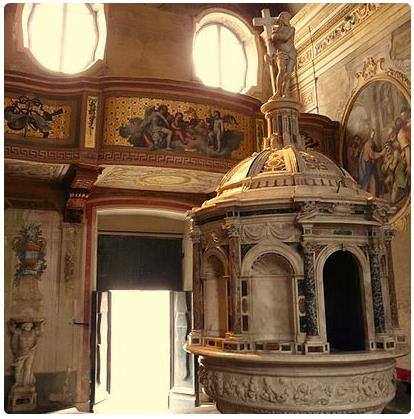 The
Baptistery of Pietrasanta, also known as the Oratory
of San Giacinto, is of great artistic elegance. It was built
in the seventeenth century on commission of the Compagnia del
Santissimo Sacramento, even if of that period remains today
the only altarpiece. Inside are preserved some works from an
earlier historical period, here transferred in the second half
of the eighteenth century; one of the two baptismal sources
present dates back to 1389 and is the work of Bonuccio Pardini,
who elaborated it with precious bas-reliefs. The other baptismal
font is the work of some more recent centuries, by sculptors
Donato Benti and Nicolò Civitali (XVI century) and
Orazio Bergamini and Fabrizio Pelliccia, who
completed it in 1612. Inside you can also admire the large
altarpiece (Eucharist and adoring angels) by Filippo Martelli,
dated 1636, the altar, the balustrade and the holy water stoves,
all from the 18th century, by Giuseppe Maria Castepoggi.
The entire complex of interior decorations, restored in 1988 and
2011, including frescoes, medallions and various sculptures, is
beautiful. The
Baptistery of Pietrasanta, also known as the Oratory
of San Giacinto, is of great artistic elegance. It was built
in the seventeenth century on commission of the Compagnia del
Santissimo Sacramento, even if of that period remains today
the only altarpiece. Inside are preserved some works from an
earlier historical period, here transferred in the second half
of the eighteenth century; one of the two baptismal sources
present dates back to 1389 and is the work of Bonuccio Pardini,
who elaborated it with precious bas-reliefs. The other baptismal
font is the work of some more recent centuries, by sculptors
Donato Benti and Nicolò Civitali (XVI century) and
Orazio Bergamini and Fabrizio Pelliccia, who
completed it in 1612. Inside you can also admire the large
altarpiece (Eucharist and adoring angels) by Filippo Martelli,
dated 1636, the altar, the balustrade and the holy water stoves,
all from the 18th century, by Giuseppe Maria Castepoggi.
The entire complex of interior decorations, restored in 1988 and
2011, including frescoes, medallions and various sculptures, is
beautiful.
Where? Via
Garibaldi (on the right side of the Duomo). When? Opening hours
for the public: every day from 8.00 a. m. to 12.30 p. m. and
from 3.30 to 7.00 p. m. (often until midnight in summer), check
the times that vary seasonally for safety.
Up
Chiesa e Chiostro di Sant'Agostino
(Church and Cloister of Sant' Agostino)
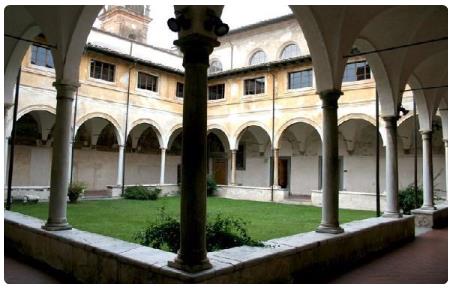 On
the Piazza del Duomo, and on the opposite side of the Cathedral,
we find the Church and the former convent of Sant' Agostino, now
no longer dedicated to worship. The church is noted for its simple
marble façade, with three large round arches, which contrasts with the
large undivided interior space. At one time the church was flanked by
the Hospital of Merchants, then closed and used as a school under
the management of the Brotherhood of the Blessed Sacrament, following
the Napoleonic period and the suppression of the monastic order. The
church was originally built by the Augustinian fathers, thanks to the
funds received from the merchants of Lucca in the 14th century,
and still today its architectural aspect, as a whole, reflects the
monastic austerity once in force. After a good restoration in the 20th
century, today the spaces are used as a suggestive location for events
and exhibitions. The Church of Sant' Agostino, is one of the most
important examples of Gothic architecture in the area of Lucca, this
despite the fact that at the end of the eighteenth century a bell tower
was added. The interior is as we said, undivided, with a nave, and you
can admire a beautiful altar of the Annunciation (assigned to Stagio
Stagi), several tombstones on the floor, some cycles of frescoes of the
fourteenth and fifteenth century (including a wall decoration of the
eighteenth century, recently recovered). The current marble altars are a
replacement of those of more ancient origin, except for the original
16th century altars, on which there was once a work by Zacchia il
Vecchio, then stolen in 1921 and of which only a few traces remain.
Among the paintings, frescoes and murals, there is also the wooden
choir, in the apse, recently restored. The atmosphere in the cloister,
flanked by the church, is typical of the places dedicated to silence:
peace and tranquility. The church and convent are linked to the figure
of
Eugenio
Barsanti, who was born in Pietrasanta
in 1821 and was ordained priest: he was not only a priest, but also an
engineer and inventor, creator and also builder of the first internal
combustion engine, built in collaboration with Felice Matteucci. On
the Piazza del Duomo, and on the opposite side of the Cathedral,
we find the Church and the former convent of Sant' Agostino, now
no longer dedicated to worship. The church is noted for its simple
marble façade, with three large round arches, which contrasts with the
large undivided interior space. At one time the church was flanked by
the Hospital of Merchants, then closed and used as a school under
the management of the Brotherhood of the Blessed Sacrament, following
the Napoleonic period and the suppression of the monastic order. The
church was originally built by the Augustinian fathers, thanks to the
funds received from the merchants of Lucca in the 14th century,
and still today its architectural aspect, as a whole, reflects the
monastic austerity once in force. After a good restoration in the 20th
century, today the spaces are used as a suggestive location for events
and exhibitions. The Church of Sant' Agostino, is one of the most
important examples of Gothic architecture in the area of Lucca, this
despite the fact that at the end of the eighteenth century a bell tower
was added. The interior is as we said, undivided, with a nave, and you
can admire a beautiful altar of the Annunciation (assigned to Stagio
Stagi), several tombstones on the floor, some cycles of frescoes of the
fourteenth and fifteenth century (including a wall decoration of the
eighteenth century, recently recovered). The current marble altars are a
replacement of those of more ancient origin, except for the original
16th century altars, on which there was once a work by Zacchia il
Vecchio, then stolen in 1921 and of which only a few traces remain.
Among the paintings, frescoes and murals, there is also the wooden
choir, in the apse, recently restored. The atmosphere in the cloister,
flanked by the church, is typical of the places dedicated to silence:
peace and tranquility. The church and convent are linked to the figure
of
Eugenio
Barsanti, who was born in Pietrasanta
in 1821 and was ordained priest: he was not only a priest, but also an
engineer and inventor, creator and also builder of the first internal
combustion engine, built in collaboration with Felice Matteucci.
Where? Via Sant'
Agostino 1
Up
Palazzo Moroni
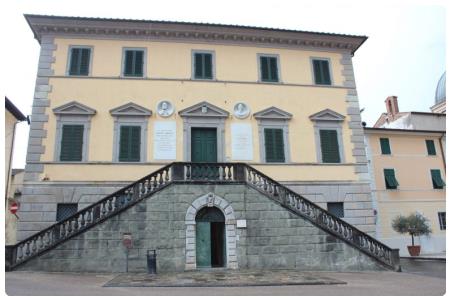 In
Piazza Duomo and in the immediate vicinity of the Cathedral, we find
Palazzo Moroni, a building with a classic architectural character on
the main façade of which stands out the double external staircase. It
has always been destined to the public functions of the city, it
originated from two older buildings already existing in the seventeenth
century, the House of Augustinian Fathers and the house of a
notary, a certain Morrone Morroni. The purpose of the palace was
then to house the Chancellery. The interior offers a pleasant visit,
with characteristic ceilings and finely decorated floors. The room on
the upper floor is particularly appreciated. Today you can visit the
palace for the Archaeological Museum Bruno Antonucci, housed here
and in which there are numerous objects dating back to the Etruscan
period, and for the presence of the Municipal Historical Archives. In
Piazza Duomo and in the immediate vicinity of the Cathedral, we find
Palazzo Moroni, a building with a classic architectural character on
the main façade of which stands out the double external staircase. It
has always been destined to the public functions of the city, it
originated from two older buildings already existing in the seventeenth
century, the House of Augustinian Fathers and the house of a
notary, a certain Morrone Morroni. The purpose of the palace was
then to house the Chancellery. The interior offers a pleasant visit,
with characteristic ceilings and finely decorated floors. The room on
the upper floor is particularly appreciated. Today you can visit the
palace for the Archaeological Museum Bruno Antonucci, housed here
and in which there are numerous objects dating back to the Etruscan
period, and for the presence of the Municipal Historical Archives.
Up
Palazzo Pretorio
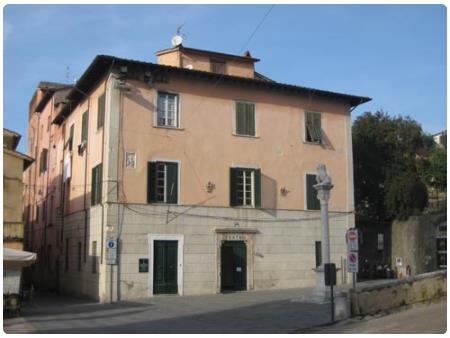 Building
seat of the Banco dei Vicari and Captains of Justice,
passed through the hands of Perotto degli Streghi (from Lucca)
when it was acquired in the fourteenth century. In the vestibule and
façade, as usual, it has numerous coats of arms of the families who
ruled Pietrasanta. It has undergone several restructuring interventions
over time, and was then purchased by the Pretura in the 19th century.
Today it houses municipal offices. Building
seat of the Banco dei Vicari and Captains of Justice,
passed through the hands of Perotto degli Streghi (from Lucca)
when it was acquired in the fourteenth century. In the vestibule and
façade, as usual, it has numerous coats of arms of the families who
ruled Pietrasanta. It has undergone several restructuring interventions
over time, and was then purchased by the Pretura in the 19th century.
Today it houses municipal offices.
Up
Torre civica (City Tower)
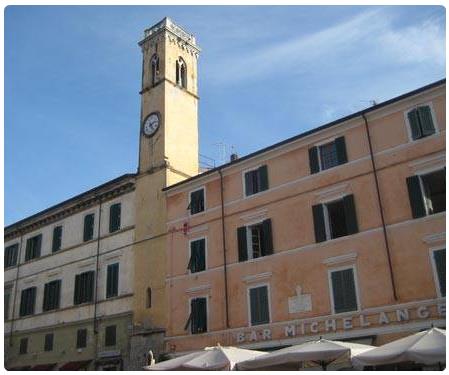
The Municipal Palace of Pietrasanta is in Piazza Matteotti 29,
just outside the historic centre of the town, Piazza Duomo, the same
square that instead houses the Civic Tower, thus being separated
from the former. Also known as Torre delle Ore, because of its
clock, it was built around 1530 and consolidated in 1706, taking on its
current appearance in 1860. The tower is located in the middle of two
buildings, with an adjoining bar and cafeteria.
Up
La Rocca di Sala (The
Fortress of Sala)
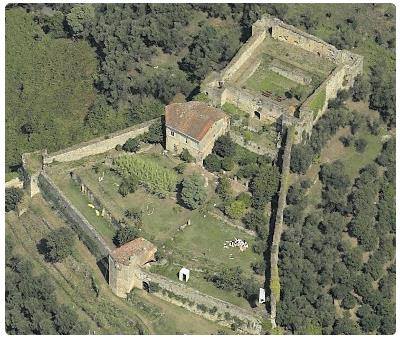 Pietrasanta
view from the top of its crenellated walls and from the Rocca that
dominates the hill, offers a unique panorama. From what remains of an
ancient fortress, you can see Piazza Duomo, the red bell tower and the
civic tower, elements that already existed centuries ago. You can
glimpse the whole plain of
Versilia from
Viareggio
to Forte dei Marmi and, in clear days of the sky, you can
see the Tuscan Archipelago beyond. Little seems to have changed up
there, making the gaze travel from this mighty fortified complex with
its square shape, angular towers and central keep. The people on these
sides call the fortress, Rocca Ghibellina, a real witness to the main
events and vicissitudes of the whole Versilia. Think, the fortress was
already present in the Lombard period and was more fortified by
Castruccio Castracani in the fourteenth century. Such was the importance
of the fortress, built at the same time as the Rocca Arrighina,
which developed Pietrasanta from them, gradually a centre more and more
attractive for the lords of
Lucca.
Paolo Guinigi himself, famous and powerful lord of Lucca in the
fifteenth century, had the opportunity to have a residence built here,
which was the place of obligatory passage for emperors and popes, such
as Charles V and Pope Paul III. The defence of the
fortress was well organized, as evidenced by the network of underground
tunnels and what remains of the walls, still visible from the square and
reachable by a path that ends directly at the Rocca. In 1700 the
fortress was sold by Leopold I, Grand Duke of Tuscany. Pietrasanta
view from the top of its crenellated walls and from the Rocca that
dominates the hill, offers a unique panorama. From what remains of an
ancient fortress, you can see Piazza Duomo, the red bell tower and the
civic tower, elements that already existed centuries ago. You can
glimpse the whole plain of
Versilia from
Viareggio
to Forte dei Marmi and, in clear days of the sky, you can
see the Tuscan Archipelago beyond. Little seems to have changed up
there, making the gaze travel from this mighty fortified complex with
its square shape, angular towers and central keep. The people on these
sides call the fortress, Rocca Ghibellina, a real witness to the main
events and vicissitudes of the whole Versilia. Think, the fortress was
already present in the Lombard period and was more fortified by
Castruccio Castracani in the fourteenth century. Such was the importance
of the fortress, built at the same time as the Rocca Arrighina,
which developed Pietrasanta from them, gradually a centre more and more
attractive for the lords of
Lucca.
Paolo Guinigi himself, famous and powerful lord of Lucca in the
fifteenth century, had the opportunity to have a residence built here,
which was the place of obligatory passage for emperors and popes, such
as Charles V and Pope Paul III. The defence of the
fortress was well organized, as evidenced by the network of underground
tunnels and what remains of the walls, still visible from the square and
reachable by a path that ends directly at the Rocca. In 1700 the
fortress was sold by Leopold I, Grand Duke of Tuscany.
Up
Rocca Arrighina
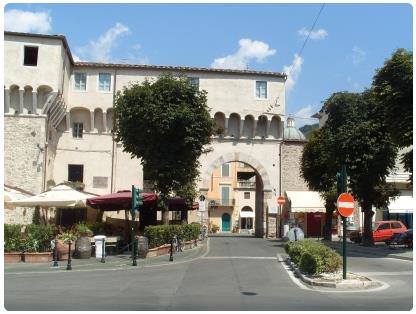 The
founding of Pietrasanta in 1255, was the result of a series of war
events started with the first expansionist attempts of Lucca. In that
historical period the whole Versilia was presented with a series of
fortifications and castles scattered in some strategic points, from
which it seems to have had life a first nucleus city. At that time, the
Podestà Guiscardo da Pietrasanta, from the fortress of Sala,
founded the urban nucleus that today bears its name. Some time later
Castruccio Castracani built a small fortress called "Arringhina" in
honor of his son, later restructured and enlarged in the fifteenth
century. The structure has undergone drastic changes over time and is
currently private. Find the fortress next to the door facing
Pisa,
also called Porta Pisana. The
founding of Pietrasanta in 1255, was the result of a series of war
events started with the first expansionist attempts of Lucca. In that
historical period the whole Versilia was presented with a series of
fortifications and castles scattered in some strategic points, from
which it seems to have had life a first nucleus city. At that time, the
Podestà Guiscardo da Pietrasanta, from the fortress of Sala,
founded the urban nucleus that today bears its name. Some time later
Castruccio Castracani built a small fortress called "Arringhina" in
honor of his son, later restructured and enlarged in the fifteenth
century. The structure has undergone drastic changes over time and is
currently private. Find the fortress next to the door facing
Pisa,
also called Porta Pisana.
Up
Museo dei Bozzetti
(Sketches Museum)
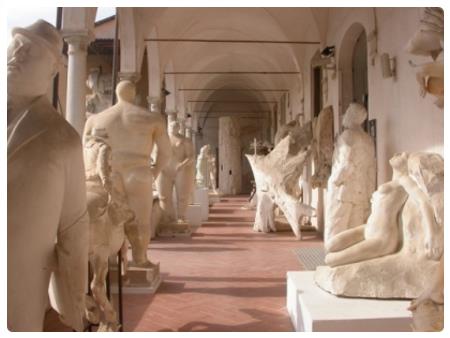 The
Pietrasanta Bozzetti Museum, (dedicated since 2007 to "Pierluigi
Gherardi"), unique of its kind in the world, is located in the former
convent of Sant' Agostino. Founded in 1984 thanks to the initiative of
the Danish art critic Jette Muhlendorf, the museum aims to document the
activity of Versilia's art workshops. Marble has always been the main
work of Pietrasanta's workshops since the 14th century. The Muhlendorf
had the idea of creating a collection of plaster casts and preparatory
works in general, documenting the activity of the artistic workshops in
Pietrasanta, today there are more than 700 sculptures of various sizes
and materials, first works by international artists famous throughout
the world... Read on the
Museum of Sketches. The
Pietrasanta Bozzetti Museum, (dedicated since 2007 to "Pierluigi
Gherardi"), unique of its kind in the world, is located in the former
convent of Sant' Agostino. Founded in 1984 thanks to the initiative of
the Danish art critic Jette Muhlendorf, the museum aims to document the
activity of Versilia's art workshops. Marble has always been the main
work of Pietrasanta's workshops since the 14th century. The Muhlendorf
had the idea of creating a collection of plaster casts and preparatory
works in general, documenting the activity of the artistic workshops in
Pietrasanta, today there are more than 700 sculptures of various sizes
and materials, first works by international artists famous throughout
the world... Read on the
Museum of Sketches.
Up
Parco
Internazionale della Scultura (International
Sculpture Park)
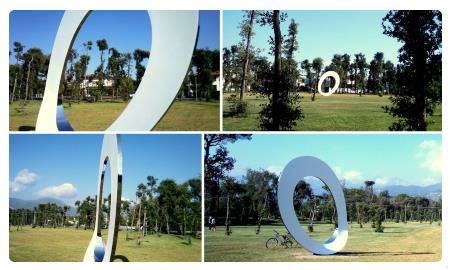 The
Sculpture Park of Pietrasanta is the ideal continuation
of the Sketch Museum in the open air and bears witness to
the local artistic imprint strongly linked to the sculptural
creations (hence the name "Little Athens"). Consisting of
more than 60 works of contemporary monumental sculpture, this
wide open-air museum itinerary winds its way through streets,
squares, gardens in the centre and the hamlets. The location of
the works inserted in the urban landscape is of great impact,
highlighting the union between the masters of sculpture who have
worked or work here and their precious and indispensable
collaborators who realize their ideas in the laboratories.
Craftsmen and skilled masters in marble working, but also in the
fusion of bronze, mosaic and inlay art. The International
Sculpture Park has a wealth of more than 30 works by renowned
artists, including Fernando Botero, Igor Mitoraj,
Kan Yasuda, Marcello Tommasi, Pietro Cascella,
Jean Michel Folon e
Novello Finotti. The
Sculpture Park of Pietrasanta is the ideal continuation
of the Sketch Museum in the open air and bears witness to
the local artistic imprint strongly linked to the sculptural
creations (hence the name "Little Athens"). Consisting of
more than 60 works of contemporary monumental sculpture, this
wide open-air museum itinerary winds its way through streets,
squares, gardens in the centre and the hamlets. The location of
the works inserted in the urban landscape is of great impact,
highlighting the union between the masters of sculpture who have
worked or work here and their precious and indispensable
collaborators who realize their ideas in the laboratories.
Craftsmen and skilled masters in marble working, but also in the
fusion of bronze, mosaic and inlay art. The International
Sculpture Park has a wealth of more than 30 works by renowned
artists, including Fernando Botero, Igor Mitoraj,
Kan Yasuda, Marcello Tommasi, Pietro Cascella,
Jean Michel Folon e
Novello Finotti.
Up
Museo Barsanti (Barsanti
Museum)
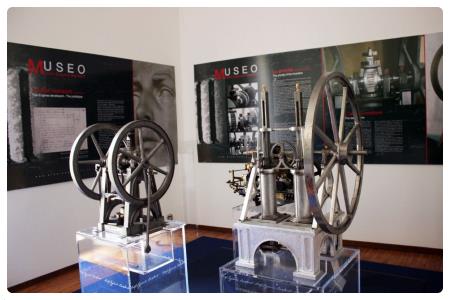 The
Barsanti Museum is located in Piazza Duomo, on the second floor
of Palazzo Panichi, opposite the new section of the Bozzetti
Museum and is dedicated to the inventor of the internal combustion
engine. In order to achieve an extraordinary invention, it is necessary
to experiment for a long time. This was the path followed by the priest
of Pietrasanta, Father Eugenio Barsanti (1821-1864) inventor, with
Felice Matteucci, of the internal combustion engine. An ingenious
creation that paved the way for an unstoppable evolution: the engine
"accelerated" the times and conquered every aspect of everyday life. The
Museum exhibits relics of the life of Barsanti, curiosities, historical
reconstructions, documents and engines. The "Premio Internazionale
Barsanti e Matteucci" promotes the knowledge of this great inventor
through the contribution of the most authoritative interpreters of
technological progress. In addition to Barsanti's life, the exhibition
offers short stories dedicated to the theme of engines and allows you to
take a dip in history with the first Fiat internal combustion engine
mounted on the first car in 1899. The
Barsanti Museum is located in Piazza Duomo, on the second floor
of Palazzo Panichi, opposite the new section of the Bozzetti
Museum and is dedicated to the inventor of the internal combustion
engine. In order to achieve an extraordinary invention, it is necessary
to experiment for a long time. This was the path followed by the priest
of Pietrasanta, Father Eugenio Barsanti (1821-1864) inventor, with
Felice Matteucci, of the internal combustion engine. An ingenious
creation that paved the way for an unstoppable evolution: the engine
"accelerated" the times and conquered every aspect of everyday life. The
Museum exhibits relics of the life of Barsanti, curiosities, historical
reconstructions, documents and engines. The "Premio Internazionale
Barsanti e Matteucci" promotes the knowledge of this great inventor
through the contribution of the most authoritative interpreters of
technological progress. In addition to Barsanti's life, the exhibition
offers short stories dedicated to the theme of engines and allows you to
take a dip in history with the first Fiat internal combustion engine
mounted on the first car in 1899.
Open on weekends in July and August at 18.30-20.00/21.00/21.00-24.00 or
on special occasions.
Via Marzo 1, Pietrasanta - 55045 (LU) Tel: 0584795369
Up
Museo Archeologico
di Pietrasanta (Archaeological Museum of
Pietrasanta)
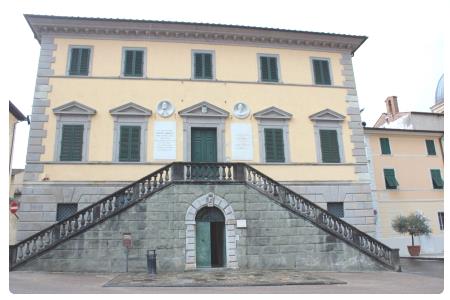 In
the Archaeological Museum of Pietrasanta is dedicated to "Bruno
Antonucci", the professor who was head of the group of archaeological
research in the territory in the 1960s and 1900s (Speleological and
Archaeological Group Versilia). The museum is home to finds found in the
sites of the Versilia district, documenting the different cultures that
have followed each other from prehistoric times to the Middle Ages, with
the addition of an interesting collection of Renaissance ceramics. The
most important section is the Etruscan and Ligurian
section, which includes a large number of Etruscan marble burial stones,
the reconstruction of some cassette tombs and other remarkable evidence
of the settlements of these populations in the area. The Museum, since
its establishment in 1968, has been housed at Palazzo Moroni in
Piazza del Duomo in Pietrasanta, first as a deposit and then as an
exhibition open to the public. The building, characterized by a double
external staircase, is one of the most interesting in the city, both
from a historical and architectural point of view, and for the public
functions to which it has always been destined. It was built in the
seventeenth century by combining two pre-existing buildings, to house in
a single complex the Monte Pio, the Chancellery and the hall of
meetings. Renovated in the mid-nineteenth century, it remained a
municipal seat until the Second World War, then welcoming the Civic
Library and later the Municipal Historical Archive and the
Archaeological Museum. In
the Archaeological Museum of Pietrasanta is dedicated to "Bruno
Antonucci", the professor who was head of the group of archaeological
research in the territory in the 1960s and 1900s (Speleological and
Archaeological Group Versilia). The museum is home to finds found in the
sites of the Versilia district, documenting the different cultures that
have followed each other from prehistoric times to the Middle Ages, with
the addition of an interesting collection of Renaissance ceramics. The
most important section is the Etruscan and Ligurian
section, which includes a large number of Etruscan marble burial stones,
the reconstruction of some cassette tombs and other remarkable evidence
of the settlements of these populations in the area. The Museum, since
its establishment in 1968, has been housed at Palazzo Moroni in
Piazza del Duomo in Pietrasanta, first as a deposit and then as an
exhibition open to the public. The building, characterized by a double
external staircase, is one of the most interesting in the city, both
from a historical and architectural point of view, and for the public
functions to which it has always been destined. It was built in the
seventeenth century by combining two pre-existing buildings, to house in
a single complex the Monte Pio, the Chancellery and the hall of
meetings. Renovated in the mid-nineteenth century, it remained a
municipal seat until the Second World War, then welcoming the Civic
Library and later the Municipal Historical Archive and the
Archaeological Museum.
Up
Teatro comunale di Pietrasanta
(Municipal Theatre of Pietrasanta)
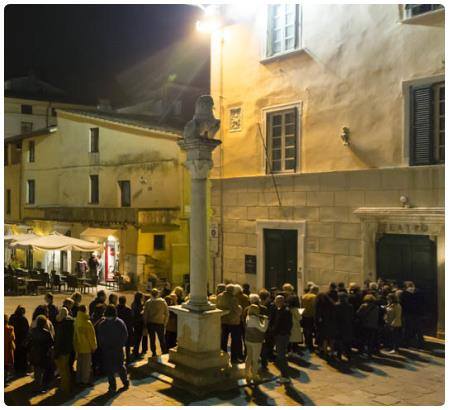 This
17th century building, which developed from an area occupied by the salt
warehouses, was rebuilt above the old structure in 1779 to provide a
venue more suitable for comedies and carnival (he performed plays,
dances and events related to the carnival). The new theatre was
inaugurated in 1784 and maintained its shape, with a horseshoe-shaped
plan and three orders of stages, until 1937. During the 1800s works by
Goldoni, Alfieri and Shakespeare were represented, as well as operas and
operettas. From 1937 a new restored theatre took the place of the
previous one, with a gallery on two levels supported by columns. Only a
few decades later the gallery was built. The theatre season of
Pietrasanta boasts leading names in the national artistic scene. This
17th century building, which developed from an area occupied by the salt
warehouses, was rebuilt above the old structure in 1779 to provide a
venue more suitable for comedies and carnival (he performed plays,
dances and events related to the carnival). The new theatre was
inaugurated in 1784 and maintained its shape, with a horseshoe-shaped
plan and three orders of stages, until 1937. During the 1800s works by
Goldoni, Alfieri and Shakespeare were represented, as well as operas and
operettas. From 1937 a new restored theatre took the place of the
previous one, with a gallery on two levels supported by columns. Only a
few decades later the gallery was built. The theatre season of
Pietrasanta boasts leading names in the national artistic scene.
Up
Statue nel laboratorio dello scultore Palla
(Statues in the workshop of the sculptor Palla)
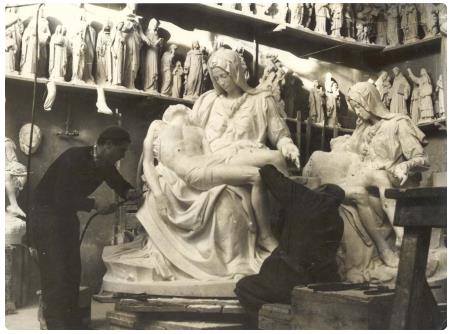 Located
in the historic center of Pietrasanta and known all over the world, we
find an ancient artistic workshop of marble processing. In these rooms,
almost by magic, sinuous and elegant shapes were born, thanks to
Ferdinando Palla, artist and director of the School of Fine Arts
of Pietrasanta. In 1868 Palla founded his marble laboratory, a real
workshop with sculptors' department, stonemasons, ornaments, polishers
and so on; this workshop has gone from the creation of classical and
sacred sculpture, to monumental and ecclesiastical sculptures, to the
most modern forms of architecture. The workshop is located in the
historic center of Pietrasanta, inside you will find an army of statues,
beautiful and strong young people, hands, feet and heads. For four
generations the Palla family has continued the work of the founder (who
was renowned throughout the world for the reproduction of ancient works
and religious statues), although after the splitting of the company the
property was divided between brothers, with the consequent shift of
production workshops. Located
in the historic center of Pietrasanta and known all over the world, we
find an ancient artistic workshop of marble processing. In these rooms,
almost by magic, sinuous and elegant shapes were born, thanks to
Ferdinando Palla, artist and director of the School of Fine Arts
of Pietrasanta. In 1868 Palla founded his marble laboratory, a real
workshop with sculptors' department, stonemasons, ornaments, polishers
and so on; this workshop has gone from the creation of classical and
sacred sculpture, to monumental and ecclesiastical sculptures, to the
most modern forms of architecture. The workshop is located in the
historic center of Pietrasanta, inside you will find an army of statues,
beautiful and strong young people, hands, feet and heads. For four
generations the Palla family has continued the work of the founder (who
was renowned throughout the world for the reproduction of ancient works
and religious statues), although after the splitting of the company the
property was divided between brothers, with the consequent shift of
production workshops.
Among the modern art galleries in Pietrasanta (over 15) we mention the
Galleria La Subbia (11 Via Padre Eugenio Barsanti) and the
Galleria Tega (Via Provinciale Vallecchia 56) where you can see
works by a famous Tuscan artist, Sandro Chia and the avant-garde
duo Christo and Jeanne-Claude.
Up
Colonna del Marzocco (Marzocco
Column)
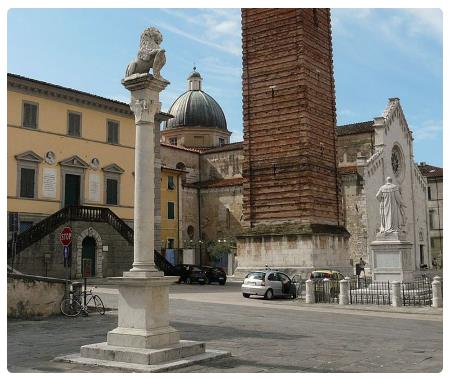 As
in many other important villages of Tuscany, also in Pietrasanta, the Lion of
Marzocco, which symbolized the Florentine domination, was exhibited in the
squares. Pietrasanta passed under the dominion of Florence in 1485 and the
Column of Liberty surmounted by the Marzocco erected by the Florentine
sculptor Donato Benti (who was a trusted man by Michelangelo), was
erected in those years. We find the name of the sculptor Benti quoted in several
payments for small works made for the Opera del Duomo di Pietrasanta as "Master
of Door", perhaps because he was committed to strengthening the walls and the
door of the city. In the nineteenth century, the fountain with three trays, with
marble bandage of 1545, present next to the Marzocco, was moved here, near the
climb to the Rocca, from the nearby square. The name "Marzocco" derives from the
fact of bearing on the top a representation, called "Marzocco", consisting of a
lion sitting with the right paw holding the shield with the lily of Florence.
This type of representation is one of the oldest emblems of Florence. As
in many other important villages of Tuscany, also in Pietrasanta, the Lion of
Marzocco, which symbolized the Florentine domination, was exhibited in the
squares. Pietrasanta passed under the dominion of Florence in 1485 and the
Column of Liberty surmounted by the Marzocco erected by the Florentine
sculptor Donato Benti (who was a trusted man by Michelangelo), was
erected in those years. We find the name of the sculptor Benti quoted in several
payments for small works made for the Opera del Duomo di Pietrasanta as "Master
of Door", perhaps because he was committed to strengthening the walls and the
door of the city. In the nineteenth century, the fountain with three trays, with
marble bandage of 1545, present next to the Marzocco, was moved here, near the
climb to the Rocca, from the nearby square. The name "Marzocco" derives from the
fact of bearing on the top a representation, called "Marzocco", consisting of a
lion sitting with the right paw holding the shield with the lily of Florence.
This type of representation is one of the oldest emblems of Florence.
Up
Borgo di Valdicastello (Village of
Valdicastello)
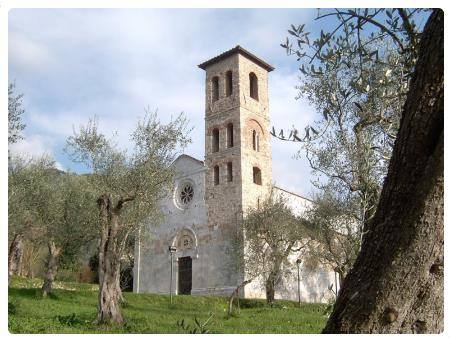 A
few hundred meters from Pietrasanta, there is the small village of
Valdicastello (about 1000 inhabitants) characterized by the interesting
parish church of San Giovanni and Santa Felicita. Quoted in the ninth
century, it owes its name perhaps to ancient fortifications that have now
disappeared. The presence of the so-called little margins (votive columns
dedicated to Jesus and Our Lady) is curious, numerous in the village, a sign of
the great religiosity of the past. In addition to the parish church, the
parish church of Santa Maria Assunta and San Giuseppe and the little
church of Santa Maria should also be mentioned. The village is famous above
all because there is the birthplace of Giosuè Carducci, which we will
talk about shortly. Just outside, a quarter of an hour's walk from Valdicastello,
stands the Madonna del Pizzetto. Between ancient churches, an unspoilt
nature, abandoned mines, Valdicastello is certainly a fascinating stopover for
those who decide to visit Pietrasanta. A
few hundred meters from Pietrasanta, there is the small village of
Valdicastello (about 1000 inhabitants) characterized by the interesting
parish church of San Giovanni and Santa Felicita. Quoted in the ninth
century, it owes its name perhaps to ancient fortifications that have now
disappeared. The presence of the so-called little margins (votive columns
dedicated to Jesus and Our Lady) is curious, numerous in the village, a sign of
the great religiosity of the past. In addition to the parish church, the
parish church of Santa Maria Assunta and San Giuseppe and the little
church of Santa Maria should also be mentioned. The village is famous above
all because there is the birthplace of Giosuè Carducci, which we will
talk about shortly. Just outside, a quarter of an hour's walk from Valdicastello,
stands the Madonna del Pizzetto. Between ancient churches, an unspoilt
nature, abandoned mines, Valdicastello is certainly a fascinating stopover for
those who decide to visit Pietrasanta.
Up
Casa natale Giosuè Carducci
(Birthplace of Giosuè Carducci)
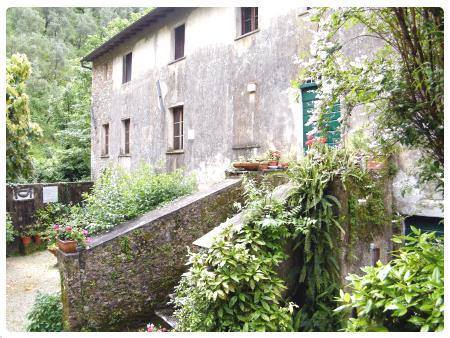 In
the hamlet of Valdicastello, which we have just talked about,
there is the birthplace of the great poet and Nobel Prize winner
Giosuè Carducci (Valdicastello di Pietrasanta, 27 July 1835?
Bologna, 16 February 1907). Declared "National Monument" since 1907, the
museum house offers the opportunity to visit four rooms of the building
furnished with furniture belonging to Carducci, who was born here in
February 1835. The father of the poet, Michele Carducci, was a surgeon's
doctor employed by a local firm. After the bankruptcy of this company in
1836, the Carducci left the village. The poet returned to his native
town only in 1890, when he was 55 years old. Since 1907, the year of the
death of the Poet, the Municipality of Pietrasanta has organized events
and commemorations in memory of this important figure of Italian
literature. In 1950 the National Poetry Award "Giosuè Carducci"vwas
established in his memory. Entrance to the house of birth is free,
opening hours depend on the season. Winter timetables are open from
Tuesday to Sunday from 5 pm to 8 pm; winter time is open on Tuesdays
from 9 am to 12 pm and on Saturdays and Sundays from 3 pm to 6 pm. Check
times for safety. In
the hamlet of Valdicastello, which we have just talked about,
there is the birthplace of the great poet and Nobel Prize winner
Giosuè Carducci (Valdicastello di Pietrasanta, 27 July 1835?
Bologna, 16 February 1907). Declared "National Monument" since 1907, the
museum house offers the opportunity to visit four rooms of the building
furnished with furniture belonging to Carducci, who was born here in
February 1835. The father of the poet, Michele Carducci, was a surgeon's
doctor employed by a local firm. After the bankruptcy of this company in
1836, the Carducci left the village. The poet returned to his native
town only in 1890, when he was 55 years old. Since 1907, the year of the
death of the Poet, the Municipality of Pietrasanta has organized events
and commemorations in memory of this important figure of Italian
literature. In 1950 the National Poetry Award "Giosuè Carducci"vwas
established in his memory. Entrance to the house of birth is free,
opening hours depend on the season. Winter timetables are open from
Tuesday to Sunday from 5 pm to 8 pm; winter time is open on Tuesdays
from 9 am to 12 pm and on Saturdays and Sundays from 3 pm to 6 pm. Check
times for safety.
For information and reservations:
Office of Cultural Institutes Municipality of Pietrasanta tel 0584 795500
E-mail: istituti.culturali@comune.pietrasanta.lu.it
Up
Marina di
Pietrasanta
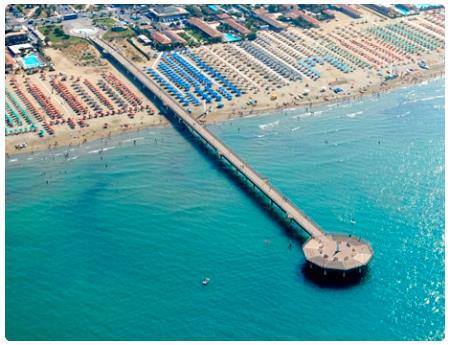 Marina
di Pietrasanta is a seaside resort in Tuscany. The hamlet of
Pietrasanta and part of the renowned Versilia Riviera, in the
province of Lucca, is flanked by other well-known seaside
resorts, such as Forte dei Marmi, Viareggio and Lido di
Camaiore. Blue sea on one side and mountains on the other, wide
beaches and super organized beaches and beaches, and then still lush
pinewoods, lively nightlife (here there are several famous discos), and
high concentration of bars and restaurants, trendy shops and beautiful
houses to be the frame.... Read on
Marina di Pietrasanta. Marina
di Pietrasanta is a seaside resort in Tuscany. The hamlet of
Pietrasanta and part of the renowned Versilia Riviera, in the
province of Lucca, is flanked by other well-known seaside
resorts, such as Forte dei Marmi, Viareggio and Lido di
Camaiore. Blue sea on one side and mountains on the other, wide
beaches and super organized beaches and beaches, and then still lush
pinewoods, lively nightlife (here there are several famous discos), and
high concentration of bars and restaurants, trendy shops and beautiful
houses to be the frame.... Read on
Marina di Pietrasanta.
Copyright © Informagiovani-italia. com. Reproduction in whole
or in part, in any form, on any medium and by any means is prohibited
without written permission.
If you liked this guide and would like to help Informagiovani-italia. com
help us spread it.
Up
Ostelli Pietrasanta Ostelli Italia
Auberges de Jeunesse Italie
Hotel Pietrasanta
Carte de Pietrasanta
Karte von Pietrasanta Mapa Pietrasanta
Map of Pietrasanta Carte
de la Toscane
Karte von Toskana
Mapa Toscana Map of
Tuscany
Carte d'Italie
Karte von Italien
Mapa Italia
Map of Italy |
